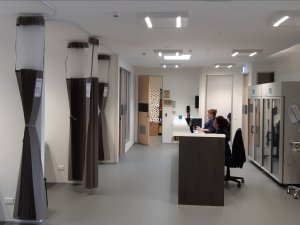Respiratory physician Lutz Beckert considers chronic obstructive pulmonary disease management, including the prevention of COPD, the importance of smoking cessation and pulmonary rehabilitation, and the lifesaving potential of addressing treatable traits. He also discusses the logic of inhaler therapy, moving from single therapy to dual and triple therapy when indicated, as well as other aspects of management
Deprivation requires a response: ‘Build back better’ for the health of Pacific peoples
Deprivation requires a response: ‘Build back better’ for the health of Pacific peoples
![Samoan art [Image: Tarres ChiTar]](/sites/default/files/styles/cropped_image_16_7_/public/2023-06/Samoan%20art%20by_CR_Tarres%20ChiTar.jpg?itok=Ji2gQJHE)
A research team has produced the largest-ever dataset on general practice in New Zealand. Research leads Nicolette Sheridan, Debbie Ryan, Jacqueline Schmidt-Busby, Teuila Percival, Tim Kenealy and Tom Love report on Pacific patient health outcomes in all models of general practice. They found patients in Pacific practices were more likely to experience mental deprivation.
This is the final part of the five part series from these authors. Read the first article here
The study included 312,670 Pacific patients enrolled in 924 practices, with 29,715 in 15 Pacific-owned practices at September 2018.
Models of practice. Pacific-owned practices were one of seven models of general practice; most (11 of 15) were owned by a trust or NGO. Other models were: traditional, corporate, PHO/DHB, trust/NGO, Pacific practices and Health Care Homes.
Traditional practices were the dominant model and enrolled 49 per cent of all Pacific patients and 73 per cent of the total enrolled population. Corporate practices enrolled a further 33 per cent of all Pacific patients.
In the average Pacific practice, 62 per cent of patients were Pacific, about five times the percentage of Pacific peoples in traditional practices (12 per cent), 10 times the percentage in Health Care Homes (6 per cent), and four times the percentage in corporate practices (14 per cent).
The study aim was to determine whether differences in patient health outcomes for Pacific peoples were associated with different models of practice.
Pacific practices overlapped with other practice models, constituting 11 (of 99) trust/NGO practices, one (of 127) HCH practices, none (of 103) corporate practices, and four (of 695) traditional practices.
Pacific practice size was smaller, with more younger and fewer older patients; there was a much larger percentage of Pacific patients than for total practices. Pacific practices were much more likely to hold a Very Low Cost Access contract, with lower patient copayments (87 per cent compared with 30 per cent for total practices).
Rural practices. No Pacific practices were rural. Fewer Pacific patients lived rurally compared with the total population.
Patient healthcare needs. Patients in Pacific practices were more likely to experience material deprivation, more likely to be dispensed an antibiotic, less likely to be dispensed a selective serotonin reuptake inhibitor, more likely to have diabetes and multimorbidity, and less likely to have continuity of practice.
Preventive care. The highest percentage of cervical screening (78 per cent) and cardiovascular risk assessment (73 per cent) was undertaken by nurses in Pacific practices. The highest rates of preventive care (cervical screening, cardiovascular risk assessment, PHQ9 mental health assessment, HbA1c testing) were in Pacific, trust/NGO and Māori practices.
Clinical input. In Pacific practices, considerably more nurse (61 per cent) and doctor (6 per cent) time (FTE) was spent with patients than in total practices. The median registered nurse FTE per 1000 patients was higher in Pacific (0.87) than in total practices (0.54). The median GP FTE per 1000 patients was similar in Pacific (0.67) and total practices (0.63).
Consultations after hours. A higher percentage of after-hours consultations were undertaken by a nurse or nurse practitioner than a GP in Pacific practices and PHO/DHB practices.
Consultations with patients not enrolled in a practice. Almost twice as many casual or walk-in patients were seen by a nurse than a GP in a Pacific practice (40 per cent) compared to a traditional (23 per cent), corporate (23 per cent) or Health Care Home (18 per cent) practice.
Outcomes for Pacific patients in Pacific practices were similar to other practice models with respect to polypharmacy, up-to-date immunisations at six months, ambulatory sensitive hospitalisations, or emergency department attendance (despite an enrolled patient profile suggesting increased need for primary care). Pacific practices had a slightly lower rate of HbA1c testing in people with diabetes.
READ THE SERIES:
- Patient need the crucial factor: Study of general practice models shows there are no ‘stars’
- Who are our practices serving? Need profile of enrolled patients varies dramatically
- Obligations to Hauora Māori: Māori general practices — a right to lead health services
- Nurses’ work is often invisible: Nurse work varied dramatically across models of primary care
Patient healthcare needs. Pacific patients were more likely to be dispensed antibiotics; to have diabetes and a higher multimorbidity score; and less likely to be dispensed tramadol or the most common type of antidepressant.
First Specialist Assessments (FSA). The Pacific rate of FSA was lower than for the total population (6.7 per cent with one FSA compared with 8.1 per cent). Given the overall high health needs of Pacific peoples, the higher rate of FSA not attended within the last year is concerning. FSA referrals are generated from both primary and secondary care so more information is required to establish what might be inappropriately low referral rates.
Nurse, NP, and GP time (FTE). Pacific, Māori and trust/NGO practices had the highest nursing workforce (medians 0.87, 0.98 and 1.09 FTE, respectively) compared with 0.69 for total practices. The median total workforce, nursing together with GPs, was Pacific (1.54 FTE), Māori (1.66 FTE) and trust/ NGO 1.78 FTE).
- Fifteen Pacific-owned practices (2 per cent of practices) enrolled 29,715 (10 per cent of all Pacific peoples).
- The average Pacific practice had 62 per cent Pacific patients compared to 7 per cent Pacific across all practices.
- Pacific practices enrolled nearly three times as many patients living in the highest-deprivation areas, and patients with higher average multimorbidity.
- Pacific practices were often in locations where there had been limited access to affordable primary care or care that could meet Pacific cultural and linguistic needs.
- Pacific practices had higher cardiovascular risk assessment rates than, and similar rates of cervical screening and HbA1c tests to, those of total practices.
- Considerably more registered nursing (61 per cent) and more GP (6 per cent) FTE was spent in face-to-face consultations with patients in Pacific practices than in total practices.
- Nurse consultation rates after hours and with unenrolled patients were highest in Pacific, Māori and trust/NGO models of practice.
- Patients in Pacific practices were no more likely than those in total practices to attend a First Specialist Assessment.
- Forty-nine per cent of Pacific patients were enrolled in traditional practices, the dominant model (695 of 924 practices), that included 73 per cent of the total population. Corporate practices enrolled 33 per cent of all Pacific patients.
- Higher levels of Pacific patients (54 per cent) were living in quintile 5 deprivation areas compared with the total population (19 per cent).
- Pacific patients were on average younger than the total population, with 28 per cent aged 14 years or under, and 7 per cent aged 65 years or more, compared with 20 per cent and 16 per cent, respectively.
- Pacific patients were much more likely to be dispensed antibiotics, less likely to be dispensed tramadol, and much less likely to be dispensed a selective serotonin reuptake inhibitor, the most common type of antidepressant.
- Nursing workforce and total workforce were similar in practices with a high percentage of Pacific patients (greater than 30 per cent) or a low percentage (30 per cent or under).
- Primary care needs of many Pacific patients remain unmet, despite increased clinical input.
Recommendations
- We recommend prioritised funding for under-resourced Pacific practices, and accountability for the health outcomes of Pacific patients in all models of general practice.
Dr Nelson Aguirre-Duarte, Comprehensive Care, Aotearoa New Zealand nelson@comprehensivecare.co.nz
Professor Bruce Arroll, University of Auckland, Aotearoa New Zealand bruce.arroll@auckland.ac.nz
Dr Carol Atmore, WellSouth Primary Health Network, Aotearoa New Zealand carol.atmore@wellasouth.org.nz
Professor Jenny Carryer, Massey University, Aotearoa New Zealand j.b.carryer@massey.ac.nz
Professor Peter Crampton, University of Otago, Aotearoa New Zealand peter.crampton@otago.ac.nz
Professor Anthony Dowell, University of Otago, Aotearoa New Zealand tony.dowell@otago.ac.nz
Dr Tana Fishman, independent researcher, Aotearoa New Zealand tana.fishman@gmail.com
Professor Robin Gauld, University of Otago, Aotearoa New Zealand robin.gauld@otago.ac.nz
Associate professor Matire Harwood, University of Auckland, Aotearoa New Zealand m.harwood@auckland.ac.nz
Professor Karen Hoare, Massey University, Aotearoa New Zealand k.j.hoare@massey.ac.nz
Dr Gary Jackson, Te Whatu Ora – Health New Zealand Counties Manukau, Aotearoa New Zealand gary.jackson@middlemore.co.nz
Dr Rawiri McKree Jansen, Te Aka Whai Ora – Māori Health Authority, Aotearoa New Zealand rawiri.mckreejansen@health.govt.nz
Professor Ngaire Kerse, University of Auckland, Aotearoa New Zealand n.kerse@auckland.ac.nz
Ms Debra Lampshire, University of Auckland, Aotearoa New Zealand d.lampshire@auckland.ac.nz
Associate professor Lynn McBain, University of Otago, Aotearoa New Zealand lynn.mcbain@otago.ac.nz
Mr Jayden MacRae, Datacraft Analytics, Aotearoa New Zealand jayden@datacraft.nz
Professor Jane Mills, La Trobe University, Australia jane.mills@latrobe.edu.au
Professor John Øvretveit, Karolinska Institutet, Sweden jovretbis@aol.com
Dr Roshan Perera, Health Hawke’s Bay – Te Oranga o Te Matau-aMāui, Aotearoa New Zealand roshan.perera@healthhb.co.nz
Professor Martin Roland, University of Cambridge, United Kingdom mr108@cam.ac.uk
Professor Tim Stokes, University of Otago, Aotearoa New Zealand tim.stokes@otago.ac.nz
Associate professor Maria Stubbe, University of Otago, Aotearoa New Zealand maria.stubbe@otago.ac.nz
Nicolette Sheridan (Ngāpuhi, Te Hikutu, Te Māhurehure, Ngāti Pākau, Ngāti Rauwawe), project lead, is professor and head of the School of Nursing at Massey University;
Debbie Ryan (Samoan – Vailele, Sapapalii), project investigator and governance lead, is a retired GP and principal director of Pacific Perspectives;
Jacqueline Schmidt-Busby (Samoan – Falealupo, Safotu), project investigator, is tumu whakarae/chief executive of Comprehensive Care;
Teuila Percival (Samoan – Ofu, Manu’a and Puapua), project investigator, is a paediatrician at Te Whatu Ora Counties Manukau;
Tim Kenealy, project co-lead and specialist GP, has an honorary appointment in the Department of General Practice and Primary Health Care, at the University of Auckland;
Tom Love, project co-lead, is a director of Sapere Research Group, an international research organisation
We're publishing this article as a FREE READ so it is FREE to read and EASY to share more widely. Please support us and our journalism – subscribe here
One of the benefits of subscribing is you will also be able to share your thoughts about what you read with other in our Comment Stream. You can also take notes on what you read with Capture









![Barbara Fountain, editor of New Zealand Doctor Rata Aotearoa, and Paul Hutchison, GP and senior medical clinician at Tāmaki Health [Image: Simon Maude]](/sites/default/files/styles/thumbnail_cropped_100/public/2025-03/Barbara%20Fountain%2C%20editor%20of%20New%20Zealand%20Doctor%20Rata%20Aotearoa%2C%20and%20Paul%20Hutchison%2C%20GP%20and%20senior%20medical%20clinician%20at%20T%C4%81maki%20Health%20CR%20Simon%20Maude.jpg?itok=-HbQ1EYA)
![Lori Peters, NP and advanced health improvement practitioner at Mahitahi Hauora, and Jasper Nacilla, NP at The Terrace Medical Centre in Wellington [Image: Simon Maude]](/sites/default/files/styles/thumbnail_cropped_100/public/2025-03/2.%20Lori%20Peters%2C%20NP%20and%20advanced%20HIP%20at%20Mahitahi%20Hauora%2C%20and%20Jasper%20Nacilla%2C%20NP%20at%20The%20Terrace%20Medical%20Centre%20in%20Wellington%20CR%20Simon%20Maude.jpg?itok=sUfbsSF1)
![Ministry of Social Development health and disability coordinator Liz Williams, regional health advisors Mary Mojel and Larah Takarangi, and health and disability coordinators Rebecca Staunton and Myint Than Htut [Image: Simon Maude]](/sites/default/files/styles/thumbnail_cropped_100/public/2025-03/3.%20Ministry%20of%20Social%20Development%27s%20Liz%20Williams%2C%20Mary%20Mojel%2C%20Larah%20Takarangi%2C%20Rebecca%20Staunton%20and%20Myint%20Than%20Htut%20CR%20Simon%20Maude.jpg?itok=9ceOujzC)
![Locum GP Helen Fisher, with Te Kuiti Medical Centre NP Bridget Woodney [Image: Simon Maude]](/sites/default/files/styles/thumbnail_cropped_100/public/2025-03/4.%20Locum%20GP%20Helen%20Fisher%2C%20with%20Te%20Kuiti%20Medical%20Centre%20NP%20Bridget%20Woodney%20CR%20Simon%20Maude.jpg?itok=TJeODetm)
![Ruby Faulkner, GPEP2, with David Small, GPEP3 from The Doctors Greenmeadows in Napier [Image: Simon Maude]](/sites/default/files/styles/thumbnail_cropped_100/public/2025-03/5.%20Ruby%20Faulkner%2C%20GPEP2%2C%20with%20David%20Small%2C%20GPEP3%20from%20The%20Doctors%20Greenmeadows%20in%20Napier%20CR%20Simon%20Maude.jpg?itok=B0u4wsIs)
![Rochelle Langton and Libby Thomas, marketing advisors at the Medical Protection Society [Image: Simon Maude]](/sites/default/files/styles/thumbnail_cropped_100/public/2025-03/6.%20Rochelle%20Langton%20and%20Libby%20Thomas%2C%20marketing%20advisors%20at%20the%20Medical%20Protection%20Society%20CR%20Simon%20Maude.jpg?itok=r52_Cf74)
![Specialist GP Lucy Gibberd, medical advisor at MPS, and Zara Bolam, urgent-care specialist at The Nest Health Centre in Inglewood [Image: Simon Maude]](/sites/default/files/styles/thumbnail_cropped_100/public/2025-03/7.%20Specialist%20GP%20Lucy%20Gibberd%2C%20medical%20advisor%20at%20MPS%2C%20and%20Zara%20Bolam%2C%20urgent-care%20specialist%20at%20The%20Nest%20Health%20Centre%20in%20Inglewood%20CR%20Simon%20Maude.jpg?itok=z8eVoBU3)
![Olivia Blackmore and Trudee Sharp, NPs at Gore Health Centre, and Gaylene Hastie, NP at Queenstown Medical Centre [Image: Simon Maude]](/sites/default/files/styles/thumbnail_cropped_100/public/2025-03/8.%20Olivia%20Blackmore%20and%20Trudee%20Sharp%2C%20NPs%20at%20Gore%20Health%20Centre%2C%20and%20Gaylene%20Hastie%2C%20NP%20at%20Queenstown%20Medical%20Centre%20CR%20Simon%20Maude.jpg?itok=Z6u9d0XH)
![Mary Toloa, specialist GP at Porirua and Union Community Health Service in Wellington, Mara Coler, clinical pharmacist at Tū Ora Compass Health, and Bhavna Mistry, specialist GP at Porirua and Union Community Health Service [Image: Simon Maude]](/sites/default/files/styles/thumbnail_cropped_100/public/2025-03/9.%20Mary%20Toloa%2C%20Porirua%20and%20Union%20Community%20Health%20Service%20in%20Wellington%2C%20Mara%20Coler%2C%20T%C5%AB%20Ora%20Compass%20Health%2C%20and%20Bhavna%20Mistry%2C%20PUCHS%20CR%20Simon%20Maude.jpg?itok=kpChr0cc)